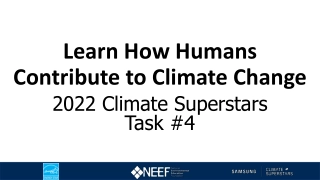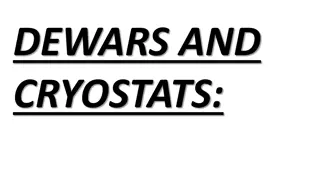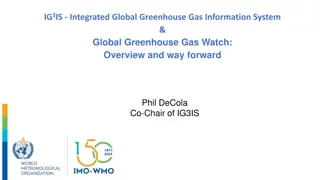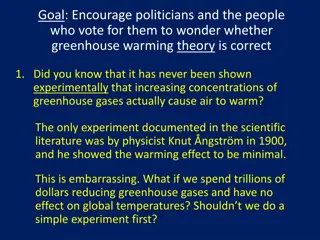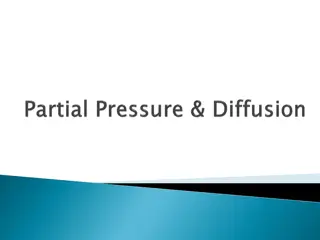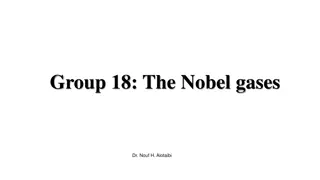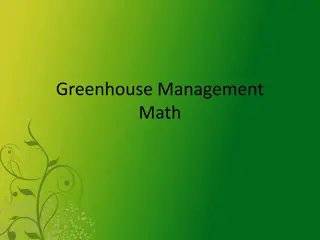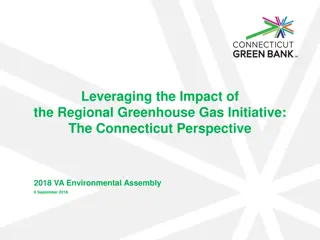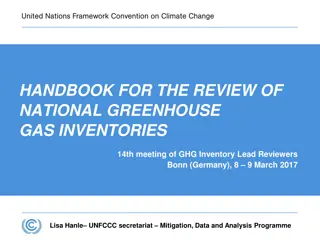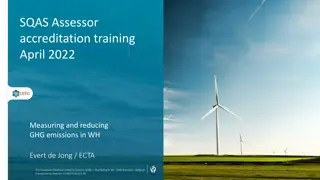Economic Framework for Greenhouse Gases: Recent Insights
A comprehensive analysis of the social cost of greenhouse gases, including recent RFF research and EPA estimates, using a stochastic discounting approach. Explore a modular framework for calculating the SCC and RFF Socioeconomic Projections on global CO2 emissions and economic growth. Learn about the implementation of modern climate models in assessing climate responses and uncertainties for informed decision-making.
Download Presentation

Please find below an Image/Link to download the presentation.
The content on the website is provided AS IS for your information and personal use only. It may not be sold, licensed, or shared on other websites without obtaining consent from the author. Download presentation by click this link. If you encounter any issues during the download, it is possible that the publisher has removed the file from their server.
E N D
Presentation Transcript
The Social Cost of Greenhouse Gases: Recent RFF Research, Recent EPA Estimates, and the Stochastic Discounting Approach Billy Pizer, Resources for the Future April 3, 2023 | CEPR
*The views expressed in this paper are those of the authors and do not necessarily reflect the views or policies of the US Environmental Protection Agency 4
RFF Socioeconomic Projections (RFF-SPs) Global CO2 emissions Population Growth in GDP per capita Shaded areas are 25-75% and 5-95% ranges. 10,000 draws of RFF-SP trajectories available at https://zenodo.org/record/6016583.
RFF-SPs: Economic Growth (country level) Methods: Country-level econometric growth projections to 2300*, constrained using expert uncertainty from RFF Economic Growth Survey** Results: Median projection from experts shows much lower long-run growth than statistical model Both sources view extremely high (>4%) and low (~0%) long-run growth as highly unlikely, but possible * M ller, Stock, Watson (2022 REStat) ** Rennert et al. (2021 BPEA) Solid black is RFF-SP mean, dashed black is RFF-SP median. Shaded areas represent 5-95% and 1-99% ranges.
Implementation of modern climate models Global Temperatures CO2 Concentrations Response of the climate system represented by the FaIR* climate model, the BRICK & FACTS sea level rise models**, and a modeled response of ocean acidification*** Ocean Acidification Sea Level Rise Sampling emissions trajectories from the RFF-SPs as well as from the climate model parameters incorporates compounding uncertainties from both elements Acidification * Forster et al. (2021), Smith et al. (2021), ** Wong et al. (2017), *** NASEM (2017) 8 Shaded areas represent 25-75% and 5-95% ranges
EPA Equally Weights 3 Sets of Damage Functions 1. Climate Impact Lab s DSCIM Sectoral Damages Mortality (Carleton et al. 2022) Agriculture (Hultgren et al. 2022) Coastal (Diaz 2016, Depsky et al. 2022) Energy (Rode et al. 2021) Labor productivity (Rode et al. 2022) 2. RFF/UC-Berkeley GIVE Sectoral Damages Mortality (Cromar et al. 2022) Agriculture (Moore et al. 2017) Coastal (Diaz 2016) Energy (Clarke et al. 2018) 3. Howard & Sterner (2017) Meta-Analysis Meta-analysis of the literature to generate a top-down damage function of market and non-market damages, relating global temperature rise to a percentage loss in GDP. 9
Stochastic discounting tied to income growth Asset pricing theory says that the appropriate discount rate varies with uncertain consumption growth Accordingly, discount rate is linked to uncertain future growth rate (subscript ? for state and ? for time): ???= ? + ???? Captures the long-term relationship between discount rates and economic growth to account for risk 10
State valuation in asset pricing, and its Ramsey-like form For an uncertain state ? (trajectory), the SCC isgiven by ? ???? ? ?? = ?=? with iso-elastic utility, ? ? = ? ?,this is equivalent to ? ???? ? ??(???/??) ? ????? ??? ??? ????= = ????? ?=? ? Discount Factor ???? ? (?+????)? = ?=? 11
Calibrated values for ? and ? ? and ? parameters calibrated via method from Newell, Pizer, and Prest (2022 JAERE) to: 1. Align with the consumption rate of interest in the near-term Focus on a 2% discount rate, reflecting consensus from recent economic literature* 2. Reflect evidence on long-run interest rate behavior** and economic growth uncertainty*** ? ? Near-term discount rate for 2% near-term rate the rule is: 1.5% 0.01% 1.02 2% 0.2% 1.24 ???= ? + ???? = ?.?% + ?.????? 2.5% 0.5% 1.42 3% 0.8% 1.57 * Giglio et al. (2015); Bauer & Rudebusch (2020, 2021); CEA (2017); Drupp et al. (2018); etc. ** Bauer & Rudebusch (2021) *** Rennert et al. (2021); M ller, Stock, & Watson, (2022)
EPA Averaged Across Three Damage Functions GIVE Model 13
Thank you. Billy Pizer(pizer@rff.org) Social Cost of Carbon Initiative: www.rff.org/SCC
RFF-SPs: Population (country level) Methods: Extend the fully probabilistic statistical approach used by the UN for official population forecasts, incorporating improvements from a panel of nine leading demographers* Results: Mean/median world population peaks at ~11B mid-next century, declines to ~7.5B in 2300, but with wide uncertainty Solid black is RFF-SP mean, dashed black is RFF-SP median. Shaded areas represent 5-95% and 1-99% ranges. * Raftery and ev kov (2021)
RFF-SPs: CO2Emissions (global) Methods: 10 experts gave probability distributions for four categories of future emissions to 2300, including experts deeply engaged in long-term scenario development. Trajectories reflect an Evolving Policies case, as used by USG. CO2 distributions conditioned on future economic growth trajectories. Results: Median projections indicate ~60% reduction of CO2 by 2100, with wide uncertainty, including net-zero emissions. Solid black is RFF-SP mean, dashed black is RFF-SP median. Shaded areas represent 5-95% and 1-99% ranges.
SCC estimates from RFFs GIVE Model (Rennert 2022, Nature) Means and distributions of the SCC from 10,000 runs of the GIVE model, for discounting approaches calibrated to 4 near-term rates Using the preferred 2% near-term discount rate, the mean SCC is $185/ton of CO2 Using a 3% discount rate, the mean SCC is $80/ton of CO2, a ~60% increase over the current federal estimate of $51/ton 17





